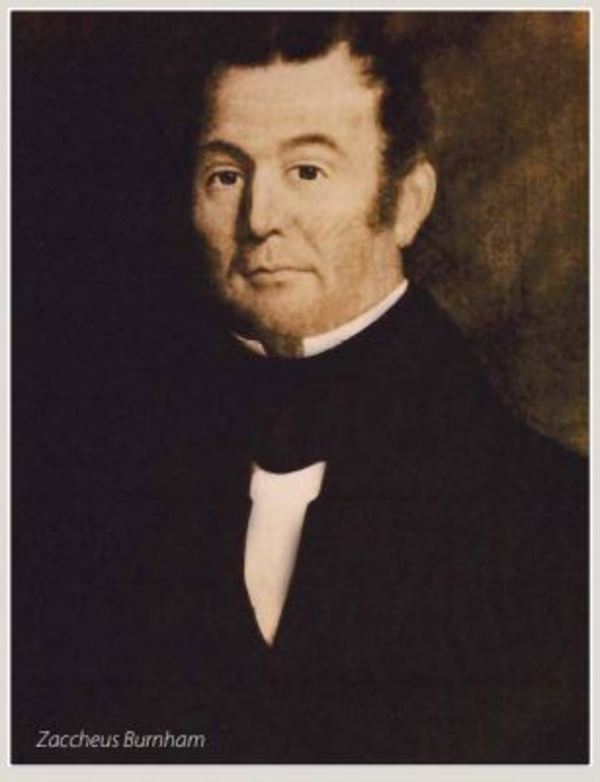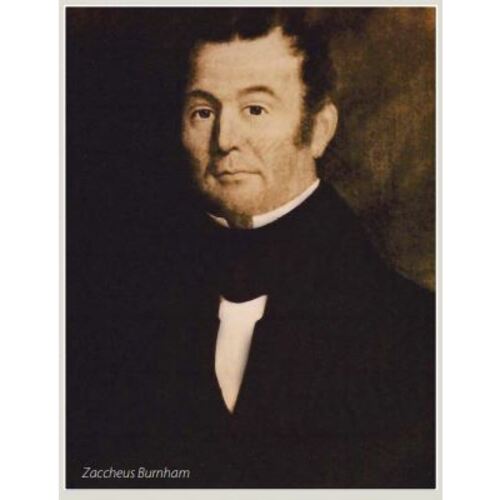
Source: Link
BURNHAM, ZACHEUS, farmer, land speculator, militia officer, justice of the peace, office holder, politician, and judge; b. 20 Feb. 1777 in Dunbarton, N.H., son of Asa Burnham and Elizabeth Cutler; m. 1 Feb. 1801 Elizabeth Choate, and they had one son and five daughters; d. 25 Feb. 1857 in Cobourg, Upper Canada.
Raised in New Hampshire, Zacheus Burnham came in 1797 to central Upper Canada, a move facilitated by his cousin Aaron Greeley, an agent for the settlement of the Newcastle District under the township land grant scheme initiated by Lieutenant Governor John Graves Simcoe*. Arriving first in Haldimand Township, Zacheus soon moved to nearby Hamilton Township where several of his brothers would eventually settle. Like many of the New England immigrants who poured into Upper Canada during the 1790s, Burnham had a passion for acquiring land. Much of the most desirable land in the townships along Lake Ontario, however, had been granted by 1801 when he brought his bride back with him from New Hampshire. The following year he and his brother Asa leased lot 21 in concession 1 of Hamilton Township, but it was not until 1805 that Zacheus obtained land of his own when he purchased the adjoining lot and established Amherst House, the farm near the site of present-day Cobourg which he occupied until his death.
Burnham thus began a process of land acquisition which would make him one of the largest land owners in the area, a process marked by favourable treatment from the provincial land authorities as well as shrewd and aggressive action on his own part. Indeed in 1819 he was cited by the Reverend John Strachan* as an Upper Canadian success story: “Mr Zaccheus Burnham had perhaps one hundred dollars or £25, when he began about twenty years ago . . . and has accumulated property worth 20,000 dollars, or £5,000.” By 1821 he held 1,780 acres in Hamilton Township. Large holdings in the interior of Newcastle District were acquired when he bid successfully in 1818 for the contract to survey the townships of Alnwick, Otonabee, Asphodel, Douro, Dummer, and parts of Smith and Percy. His reward for these surveys, which were carried out by his future son-in-law Richard Birdsall, consisted of a percentage of the land within each township, amounting to just under 13,000 acres. In the 1830s Burnham acquired additional land at tax sales, through purchase, and through the lease and purchase of crown lands. In this way he amassed a large and scattered land empire that assured him considerable financial gain through land sales with the influx of immigrants into the area during the 1830s and 1840s.
As a resident speculator familiar with the region, Burnham was quick to recognize the strategic advantage of potential mill-sites and townsites. The village of Ashburnham, directly across the Otonabee River from Peterborough, was located on land owned by Burnham as were portions of the village of Amherst (now part of Cobourg). In support of his Amherst interests, he played a critical role in preventing the court-house from being moved to nearby Cobourg in 1829. He also promoted the building of sawmills and grist-mills in the interior such as those in Keene, Lakefield, and Warsaw. Unlike some speculators Burnham took an active part in the economic development of the Newcastle District. With James Gray Bethune* and Charles Rubidge* he petitioned to have Cobourg made a port of entry in 1829, and he supported the development of road and ferry connections with the Peterborough back country during the early years of its settlement. Later he was a subscriber in the Cobourg Rail Road Company chartered in 1834 to build a railway from Cobourg to Peterborough, and served as one of the commissioners appointed to implement Nicol Hugh Baird*’s proposed canal route between Rice Lake and Lake Simcoe. Along with Henry Ruttan* and others he sought to establish the Newcastle Banking Company, a joint-stock bank founded in 1835 and chartered in 1837 as the Bank of the Newcastle District.
In addition to his many other activities, Burnham maintained a farm which far exceeded in size and standard of production those typical of early Upper Canada. At a time when most settlers were struggling to acquire and clear enough land to support their families, Burnham farmed commercially and provided the area with a local source of foodstuffs and livestock. As early as 1810 he had cleared 100 acres of land and kept a dozen head of cattle; by 1831 he kept 20 milk cows, 100 neat cattle, 150 sheep, 70 pigs, and 10 horses on a farm that spanned 1,000 acres. His farm remained one of the largest, most productive, and prosperous in the area before 1850. Unable to manage it personally because of other concerns, he employed a farm manager and a large labour force. Yet Burnham took a lively interest in his farm and was active in local agricultural affairs as befitted his role as a local squire. He was instrumental in having market fairs established in Port Hope and Cobourg in 1821. A director of the Northumberland Agricultural Society upon its founding in 1828, he later served as a show judge and as president of the society.
Literate, ambitious, and a firmly established land owner, Burnham soon rose to prominence in local militia and political affairs. First mustered as a private in 1801, by the beginning of the War of 1812 he had risen to the rank of captain, and during the war he guided the movement of government stores along Lake Ontario. He remained active in the 1st Regiment of Northumberland militia and as colonel led a large force to Toronto in response to news of the rebellion in December 1837. Burnham became a road commissioner for the Newcastle District in 1811 and two years later received his first of several commissions as justice of the peace. He was appointed district treasurer in 1815, a position he held until 1851. From 1817 to 1820 Burnham represented the riding of Northumberland and Durham in the House of Assembly, which was grappling with the problem of getting the province moving again after the unsettling war. His contribution was dutiful and workmanlike, resting with issues such as road improvements, the establishment of schools, and the adjustment of property assessment laws. When Burnham returned to the assembly in 1825, he found himself in a political arena that rapidly became polarized and contentious as the vexing alien question dominated the affairs of the house. American-born yet not a loyalist, he nevertheless aligned himself with the tory side, voting for the Naturalization Bill of 1827 [see Sir John Beverley Robinson*]. In 1831 he was appointed to the Legislative Council by Lieutenant Governor Sir John Colborne* and served there until 1841. In July 1839 he was made a judge of the district court for Newcastle.
Like many leading men in early Upper Canada, Burnham was involved in a variety of philanthropic and religious associations. During the 1830s and 1840s when Cobourg was one of the important immigrant entrepôts of the province, he was a leading figure in the Newcastle District Emigrant Relief Society and the Children’s Friend Society. He was also active in the Newcastle committee of the Society for Promoting Christian Knowledge.
At his death in 1857 Burnham was one of the oldest residents of the district, a self-made man in a society of immigrants. During his 60 years in the province, an imposing wilderness had given way to a complex and prospering society, and he had played an important role in the process. “A powerfully built man, more than six feet high, with a fine, manly countenance, and a clear head,” he exemplified for his contemporaries the human achievement of the new society, as excerpts from the funeral sermon by Archdeacon Alexander Neil Bethune* and a biographical sketch by his son-in-law Edward Ermatinger* acknowledge with ample heroic rhetoric.
Burnham left an estate still consisting principally of extensive land holdings. Because large sections had previously been ceded to his daughters it is difficult to appraise its full value; the contemporary estimate of a million dollars probably inflated his real worth. None the less Burnham had entered Upper Canada a young man without wealth; he died rich and respected. His son, Mark, attended John Strachan’s Home District Grammar School, went on to Queen’s College in Oxford, and was ordained an Anglican priest, serving as rector in St Thomas and later in Peterborough. Other relations populated the Newcastle District and were prominent in business and legal affairs throughout the remainder of the century.
A striking portrait of Zacheus Burnham is reproduced in Kawartha heritage: proceedings of the Kawartha conference, 1981, ed. A. O. Cole and Jean Murray Cole (Peterborough, Ont., 1981), 56.
AO, MS 393, C-1; MU 2388; RG 1, A-II-6, 20–21; B-II, 7–17; C-I-8, 6; RG 21, Newcastle District, Hamilton Township, census and assessment rolls, 1804, 1810, 1821, 1831, 1842, 1856; RG 22, Newcastle District, Clerk of the Peace, reg. of lands sold for taxes, 1820–60; ser.7, 96–96G; ser.155, will of Zacheus Burnham; ser.187, 1–3. N.H. Hist. Soc. (Concord), Dunbarton cemetery records, 17. N.H. State Library (Concord), “Genealogy of Dunbarton, N.H., descendants, A–J,” p.183 (mfm.; GS no.1003057); “Town records of Dunbarton, N.H.,” 1: 184 (mfm.; GS no.15124). PAC, RG 1, E3, 26: 62, 100, 122, 151; 35: 138; L3, 85: B leases, 1802–18/35; 222: G misc., 1794–1830/25 1/2; RG 5, A1: 9739, 51236–38; RG 8, I (C ser.), 688A: 138; RG 31, A1, 1842, 1848, Hamilton Township. St Peter’s Anglican Church (Cobourg, Ont.), Reg. of baptisms, marriages, and burials, 1817–37 (mfm. at AO). Edward Ermatinger, Life of Colonel Talbot, and the Talbot settlement . . . (St Thomas, [Ont.], 1859; repr. Belleville, Ont., 1972). “Journals of Legislative Assembly of U.C.,” AO Report, 1913. James Strachan [John Strachan], A visit to the province of Upper Canada, in 1819 (Aberdeen, Scot., 1820; repr. Toronto, 1968), 93. “Upper Canada land book C, 11th April, 1797, to 30th June, 1797,” AO Report, 1930: 159. “Upper Canada land book C, 29th June, 1796, to 4th July, 1796; 1st July, 1797, to 20th December, 1797,” AO Report, 1931: 62. Valley of the Trent (Guillet). Cobourg Star, 31 May 1831; 18 April, 10 Oct. 1832; 18 Nov., 22 Dec. 1835; 8 Sept. 1841; 4 March 1857. P. M. Ennals, “Land and society in Hamilton Township, Upper Canada, 1797–1861” (phd thesis, Univ. of Toronto, 1978). Guillet, Lives and times of Patriots. T. W. Poole, A sketch of the early settlement and subsequent progress of the town of Peterborough, and of each township in the county of Peterborough (Peterborough, 1867; repub. 1941, 1967), 140, 155, 175. D. E. Wattie, “Cobourg, 1784–1867” (2v., ma thesis, Univ. of Toronto, 1949).
Cite This Article
Peter Ennals, “BURNHAM, ZACHEUS,” in Dictionary of Canadian Biography, vol. 8, University of Toronto/Université Laval, 2003–, accessed April 1, 2025, https://www.biographi.ca/en/bio/burnham_zacheus_8E.html.
The citation above shows the format for footnotes and endnotes according to the Chicago manual of style (16th edition). Information to be used in other citation formats:
| Permalink: | https://www.biographi.ca/en/bio/burnham_zacheus_8E.html |
| Author of Article: | Peter Ennals |
| Title of Article: | BURNHAM, ZACHEUS |
| Publication Name: | Dictionary of Canadian Biography, vol. 8 |
| Publisher: | University of Toronto/Université Laval |
| Year of revision: | 1985 |
| Access Date: | April 1, 2025 |



